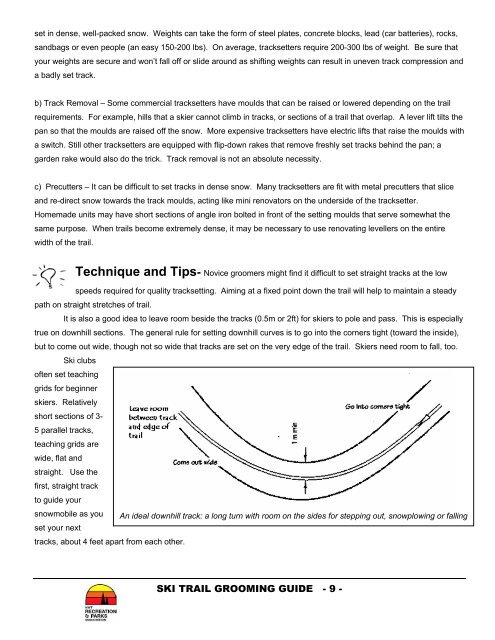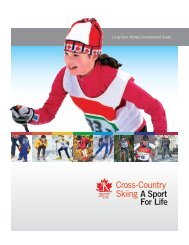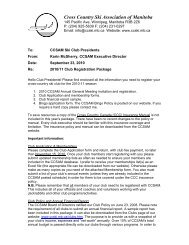You also want an ePaper? Increase the reach of your titles
YUMPU automatically turns print PDFs into web optimized ePapers that Google loves.
set in dense, well-packed snow. Weights can take the form of steel plates, concrete blocks, lead (car batteries), rocks,<br />
sandbags or even people (an easy 150-200 lbs). On average, tracksetters require 200-300 lbs of weight. Be sure that<br />
your weights are secure and won’t fall off or slide around as shifting weights can result in uneven track compression and<br />
a badly set track.<br />
b) Track Removal – Some commercial tracksetters have moulds that can be raised or lowered depending on the trail<br />
requirements. For example, hills that a skier cannot climb in tracks, or sections of a trail that overlap. A lever lift tilts the<br />
pan so that the moulds are raised off the snow. More expensive tracksetters have electric lifts that raise the moulds with<br />
a switch. Still other tracksetters are equipped with flip-down rakes that remove freshly set tracks behind the pan; a<br />
garden rake would also do the trick. Track removal is not an absolute necessity.<br />
c) Precutters – It can be difficult to set tracks in dense snow. Many tracksetters are fit with metal precutters that slice<br />
and re-direct snow towards the track moulds, acting like mini renovators on the underside of the tracksetter.<br />
Homemade units may have short sections of angle iron bolted in front of the setting moulds that serve somewhat the<br />
same purpose. When trails become extremely dense, it may be necessary to use renovating levellers on the entire<br />
width of the trail.<br />
Technique and Tips- Novice groomers might find it difficult to set straight tracks at the low<br />
speeds required for quality tracksetting. Aiming at a fixed point down the trail will help to maintain a steady<br />
path on straight stretches of trail.<br />
It is also a good idea to leave room beside the tracks (0.5m or 2ft) for skiers to pole and pass. This is especially<br />
true on downhill sections. The general rule for setting downhill curves is to go into the corners tight (toward the inside),<br />
but to come out wide, though not so wide that tracks are set on the very edge of the trail. <strong>Ski</strong>ers need room to fall, too.<br />
<strong>Ski</strong> clubs<br />
often set teaching<br />
grids for beginner<br />
skiers. Relatively<br />
short sections of 3-<br />
5 parallel tracks,<br />
teaching grids are<br />
wide, flat and<br />
straight. Use the<br />
first, straight track<br />
to guide your<br />
snowmobile as you An ideal downhill track: a long turn with room on the sides for stepping out, snowplowing or falling<br />
set your next<br />
tracks, about 4 feet apart from each other.<br />
SKI TRAIL GROOMING GUIDE - 9 -




